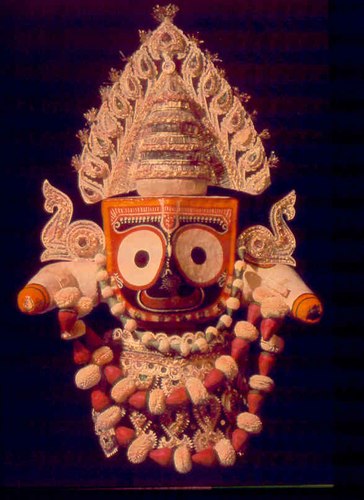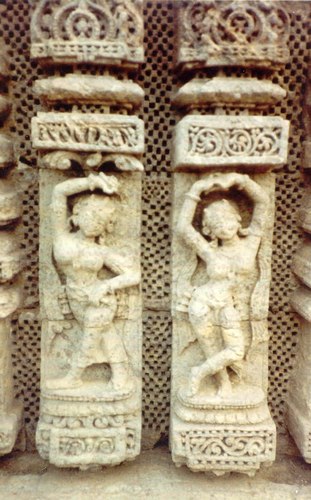|
 |
|
|
 |
 |
The cover of Nrityagram Dance Ensemble's publicity materials shows a photo of a dancer glistening with sweat from an endless dance, yet perfectly still. She looks like she could choose to move or remain still with equal perfection, waiting for just the right moment. As a photographer, I know better than most how photographs can be made to enhance a limited truth, but in this case I can assure you that this striking image is an accurate representation of Nrityagram's two hour show now playing at the Joyce Theater. I would advise you to buy tickets now, and only then read the rest of this review, just to make sure you don't miss seeing them. Odissi performances normally start with an invocation/offering. This show did so, but with a twist. The five dancers formed a circle, facing inward. The effect was to simultaneously present the offering to the audience and each other. This dance, Praarambha (hymn of creation), continues using a structural device that was both brilliant and innovative. They essentially made manifest the interface of a non-linear video editing program through the use of overlapping temporal flows. To see this structure, you need to envision each dancer as a separate video stream. Each stream contains clips (the dancer is moving) and gaps (the dancer is still). The dancers start and stop their movements at staggered and changing intervals such that layered temporal patterns are created. Not that creating temporal patterns is something new in dance, but I thought that this approach yielded a new level of complexity. Of course, it certainly helped that the clips were filled with dancing of the highest order. When Nrityagram's dancers are still, they are very still, and when they move, not a movement is out of place. Speaking of stillness, the next dance, Chhaya (image), begins with two dancers sitting on the floor for what seemed like several minutes. They only move ever so slightly, yet you can't take your eyes off of them. Eventually, one dancer stands and then the other stands. The activity slowly builds out of the initial stillness, all the more powerful for having been coiled for so long. Once in motion, the pair looked like a dancer and a reflection in a pond with partially independent volition, but never being sure who is the dancer and who is the reflection. The work moves to other sections as sometimes four and sometimes five dancers fill the stage. Here, the dance is flowing, but even at full speed the dance appears to be marked in a manner similar to good Argentine tango. The choreography returns to the two featured dancers, and then back to four. The sections with four dancers are somewhat more conventionally presentational than the pair sections, which creates a useful contrast that helps sustain the work. At the end, one dancer backs away in an unexpected flourish. All of the dancers wore traditional Odissi costumes. I think these costumes are effective because they strike a balance between amplifying the flow of motion and showing the body. The costumes were ornate without overdoing it. The next dances, Mugdha (lost in love) and Rhandita (love betrayal), tell two sections of the story of Radha and Krishna. An unseen narrator tells the story in English while one dancer mimes in place. Then the story is enacted without narration. This is repeated for the second section. The dancing here was as wonderful as everything else presented, but Nrityagram also demonstrated that they are just as polished as the best ballet companies in another respect: they showed that Odissi struggles just as much as Ballet when it comes to telling detailed narratives. I have seen enough Odissi to have seen these stories enacted several times, and yet I was still a little confused. In Mugdha, I eventually lost track of who was playing Radha and who was playing Krishna. I thought, based on what I heard from the narrator, that Radha and Krishna were enacting a lover's tryst, which is why, in the next dance, I was very confused because Radha was clearly enacting being stood up by Krishna. Later, when I read the program notes, I realized that Mugdha depicted Radha and a female friend; Krishna doesn't appear in this part of the story. My view is that when dance tries to tell stories, it should focus on broad brush strokes of plot and emotion; details of either tend to either get lost or slow the dancing too much. The other difficulty with these story-dances, for non-Indian audiences in particular, is that hand gestures in Indian dance carry specific meanings. Some of them are obvious and some are so stylized that you just have to learn them (similar to sign language in some ways). Plus, these story-dances are accompanied by verses sung from twelfth century Sanskrit poems. If you understood the meaning of both the verses and the gestures, the dance might very well successfully convey detailed plot and emotion. Even lacking both, the dances are still enjoyable on an abstract level, but knowing there is something more going on and not quite being able to make it out can be frustrating. Mugdha and Khandita is the one part of this show that I might keep experimenting with. I would suggest presenting each dance with the singing translated into English, and then repeating each dance with the singing in the original. A visual glossary of the hand gestures would be helpful too. The first dance in Act II was Vibhakta (the division). This was another abstract work. Some sections emphasized poses and some sections emphasized motion. At least once the poses raised the question,"How does she hold herself on one foot for so long while staying so still?" In addition to the majority of the dance that read as traditional Indian dance, there were also looser moments that seemed to be channeling Hip Hop, and a section that flowed like Waltz. One of the things that attracts me to Odissi, in Vibhakta especially, but also in general, is the way that they present an open, confident sensuality combined with unrelenting classiness. The final work of the night, Aarati (offering), seemed to start with four elves dancing in the dark. This was only a momentary impression, but someone really ought to call Peter Jackson and see if Nrityagram could do a gratuitous dance number in the upcoming Hobbit movie (gratuitous dance numbers being something that will enhance any movie). Some of Nrityagram's dancers' earrings look similar to the sort of jewelry that the Bajorans tend to favor on Star Trek. A gratuitous dance number by Nrityagram in the next Star Trek movie would be good too. One could probably fund several seasons of a dance company in the error margins of the budgets of movies like these. Just in case the whole elf-Bajoran thing doesn't draw you in, there were also times in this number when they danced like Cephalopods, specifically like the Moving Rock Trick: they moved across the floor so slowly and in such a way that it was almost like they weren't moving at all, yet in a relatively short period they had crossed the stage. They also managed to let the audience see what the dancers looked like from the front and the back simultaneously by positioning two dancers facing front and two dancers facing back while performing the same motions. And while they are at it, I would also like to see them stage Cinderella told through an Odissi lens. The Nutcracker has its place, but we really need additional sophisticated dance-theatre that opens the world of dance to kids. While there is nothing wrong with enjoying Odissi as a high-quality ethnic dance, tackling non-Indian stories while staying rooted in Odissi's philosophical origins might help Odissi become as internationalized as Ballet. Finally, just when I thought their show had plateaued, they pulled one more rabbit out of their hat: each dancer moved with two small lights in their hands, bathed in a soft glow from the main lights. The effect was analogous to skiing at night. The quality of the dancing was nearly perfect throughout the whole two hour show. They could have easily kept the audience thoroughly enthralled for another half an hour. The live musicians contributed significantly to the quality of the show as well. The dancers' technique was not perfect, though: I did detect one slight bobble somewhere in the middle of the two hours. I think they probably put this barely noticeable error there on purpose as if to say that only G-d is perfect.
The photo essay about Nrityagram below was composed by Rajika Puri, who also gave a talk about the company at the Joyce Soho. Ms. Puri also organized a lovely and well-attended opening night reception.
 Jagannath - 'Lord of the world' - Lord Krishna in the form of the image in the Puri temple, located in the state of Orissa, from which Odissi dance originates. Photo © & courtesy of Rajika Puri |
|
 Temple relief of the basic Odissi stance: chowk or 'square', considered by dancers as related to the pose of the Jagannath image. Photo © & courtesy of Rajika Puri |
|
 Guru Kelucharan Mohapatra one of the architects of modern Odissi dance, (teacher of the founder of Nrityagram, Protima Bedi) in a pose which represents 'kiss'. Photo © & courtesy of Sangeet Natak Akademi, New Delhi |
|
 Guru Kelucharan Mohapatra one of the architects of modern Odissi dance, (teacher of the founder of Nrityagram, Protima Bedi) in a seated pose which captures lines of the feminine body. Photo © & courtesy of Sangeet Natak Akademi, New Delhi |
|
 Gotipuas - 'boy dancers' - from village of Raghurajpur near the temple town of Puri. Photo © & courtesy of Rajika Puri |
|
 SUBASINI - one of the many ritualists who used to sing and dance for Jagannath image in the inner sanctum of Puri temple, a practice now lapsed. Photo © & courtesy of Govind Vidyarthy/Sangeet Natak Akademi |
|
 Temple sculpture of triple-bend poses of Odissi: "alasa" and "akunchana" Photo © & courtesy of Rajika Puri |
|
 The late Protima Bedi, founder of Nrityagram, in a variation on the "akunchana" pose. Photo © & courtesy of Avinash Pasricha |
|
 The village of Nrityagram ('dance village') outside Bangalore in south India. Photo © & courtesy of Rajika Puri |
|
 Honouring a great teacher of Abhinaya - 'mime' - Kalanidhi Narayanan Photo © & courtesy of Rajika Puri |
|
 Workshop in abhinaya - 'mime' - taught by Kalanidhi Narayanan at Nrityagram, with dancers like Pratibha Prahlad and Rajika Puri in the class. Photo © & courtesy of Rajika Puri |
|
 Nrityagram Dance Ensemble in performance. Photo © & courtesy of Nan Melville |
|
 Surupa Sen (Artistic Director & choreographer) and Bijayini Satpathy (Director of the Odissi Gurukul dance training). Photo © & courtesy of Nan Melville |
|
|
|














